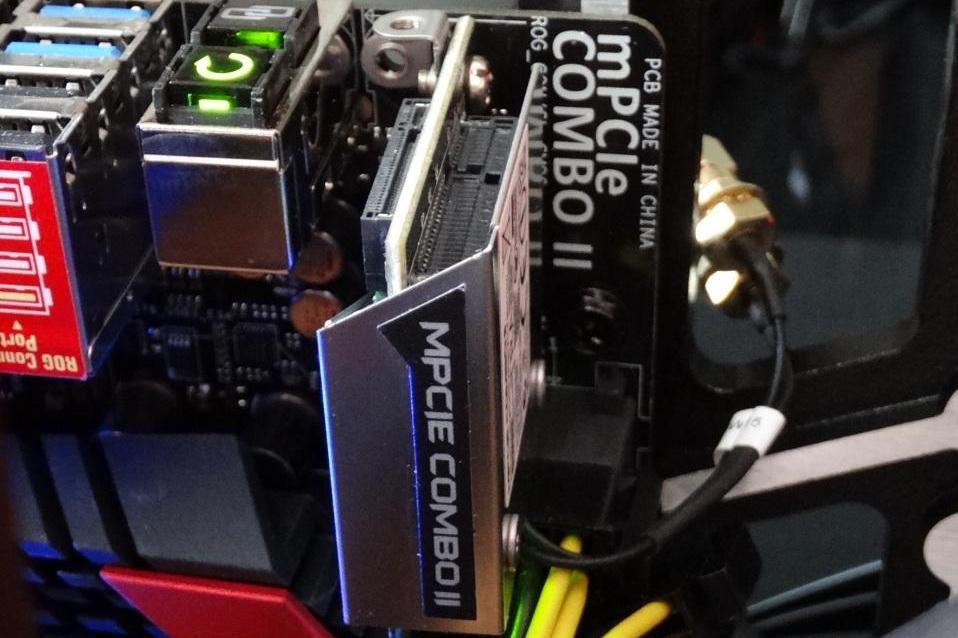Although it’s really no surprise that ASUS has included a MPCIe/802.11ac Combo with their latest Maximus VI offerings, the fact that this M.2 adapter is only limited to a single PCIe lane is a bit disheartening. Not that it really matters to the typical consumer, as they probably won’t be able to get their hands on a compatible card for a few motherboard revisions at least, but limiting it to a single lane means 5Mbps throughput, or 500MB/s transfer speeds which is less than we are seeing in todays SATA 3 SSDs.
Why ASUS only did half a job to encorporate M.2 is a bit confusing, especially since they took away Intel Z87 6Gbps ports 5 and 6 in result. Don’t get me wrong, the adapter is definitely a benefit to reviewers, however, the most useful part of this card is, without a doubt, the 802.11ac speeds that extend our wireless network by leaps and bounds. Not only are we getting speeds up to 860Mbps on 802.11ac capable systems such as our MBA, but also, all 802.11 systems are at a solid 5 bars and 300mbps at all times. – ASUS Maximus VI Pricing –![]()
QUICK AND EASY SSD SECURE ERASE
MPCIe wasn’t the only SSD related add on that ASUS included in the Maximus VI family as their is also a very easy to use secure erase utility found in the BIOS. For those not understanding the purpose of a SSD secure erase, SSDs may slow in performance over time where a secure erase can set it back to its factory fresh state. This is also a desired characteristic when passing an SSD for anothers use.
We apologize in advance that it isn’t possible to get a screen capture of the bios applications and the literature on the screen was very bright. We did our best to make it as legible as possible. Clicking on any picture will bring a larger and clearer resilution.
 At the time of this report, our new MPCIe Test Bench has been in use for two days and we had secure erased nine SSDs, all without a hitch.
At the time of this report, our new MPCIe Test Bench has been in use for two days and we had secure erased nine SSDs, all without a hitch.
 The ASUS Secure Erase Utility can be found in one of the menus of the Maximus VI UEFI bios and recognizes yous SSDs immediately, offering the opportunity for you to highlight your choice.
The ASUS Secure Erase Utility can be found in one of the menus of the Maximus VI UEFI bios and recognizes yous SSDs immediately, offering the opportunity for you to highlight your choice.
 Once you select the SSD to be cleaned, you will get a warning that completing a secure erase will erase all data and partitions. This cannot be recovered.
Once you select the SSD to be cleaned, you will get a warning that completing a secure erase will erase all data and partitions. This cannot be recovered.
 In all of our SSDs, we were told that they were frozen and a reboot was necessary to proceed. The reboot immediately returned you to the Secure Erase screen.
In all of our SSDs, we were told that they were frozen and a reboot was necessary to proceed. The reboot immediately returned you to the Secure Erase screen.

 Once the reboot is complete, the utility reflects that all drives are ready and you are able to select the drive to erase once again.
Once the reboot is complete, the utility reflects that all drives are ready and you are able to select the drive to erase once again.
 Once again, you will get a warning that all date will be deleted and cannot recovered, followed by a similar warning for partitions:
Once again, you will get a warning that all date will be deleted and cannot recovered, followed by a similar warning for partitions:
 Once you select ‘ok’ the drive is cleaned and the utility let’s you know the process is complete:
Once you select ‘ok’ the drive is cleaned and the utility let’s you know the process is complete:
 Although most buyers will never get the opportunity to use the MPCIe M.2 feature of the MPCIe/802.11ac Combo Card, Secure Erase in the UEFI bios is quick and easy and can be performed by anyone.
Although most buyers will never get the opportunity to use the MPCIe M.2 feature of the MPCIe/802.11ac Combo Card, Secure Erase in the UEFI bios is quick and easy and can be performed by anyone.
 The SSD Review The Worlds Dedicated SSD Education and Review Resource |
The SSD Review The Worlds Dedicated SSD Education and Review Resource | 

Can you not press F12 and save screen shots to a usb flash drive? Those would look better.